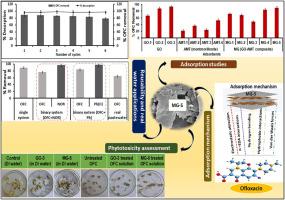Graphene oxide/montmorillonite nanocomposite for removal of antibiotics from wastewater
IF 4.7
3区 材料科学
Q2 MATERIALS SCIENCE, MULTIDISCIPLINARY
引用次数: 0
Abstract
Graphene oxide (GO) is a high potential adsorbent yet its toxicity is pronounced. With intent for an environmentally friendly solution, successful encapsulation of GO fabricated via an improved Hummers' method (GO-3) was ensured with an acid activated montmorillonite (AMT-4) as per studies revealed with the help of FTIR, XRD, Fe-SEM + EDAX, TEM, XPS and Raman analysis. The fabricated composite (MG-5) having GO-3: AMT-4 ratio of 1:0.25 showed highest stability and highest Ofloxacin (OFC) removal of 89 % at pH 6–7. Mechanistic aspect of binding as elucidated via XPS, FTIR and pH studies revealed interplay of electrostatic attraction, hydrogen bonding, π-π interactions, hydrophobic interactions, pore-filling. Three aspects worth highlighting in MG-5 is its high uptake efficiency for various other broad-spectrum antibiotics viz. Norfloxacin (NOR), Ciprofloxacin (CIP) and Tetracycline (TTC); its high reusability for 6 consecutive cycles and its significantly reduced phytotoxicity towards germination of Vigna radiata seeds and Cucumis sativus seeds. Phytotoxicity tests revealed the effective minimization of toxic effect by MG-5 or GO-3 treated wastewater towards germination of bean and cucumber seeds.
The novel aspect is the contributory role of montmorillonite towards development of an environmentally benign, advanced GO composite for wastewater treatment and in phytotoxicity management.

氧化石墨烯/蒙脱土纳米复合材料去除废水中的抗生素
氧化石墨烯(GO)是一种高潜力的吸附剂,但其毒性也很明显。根据FTIR, XRD, Fe-SEM + EDAX, TEM, XPS和拉曼分析的研究结果,通过改进Hummers方法(GO-3)制备的氧化石墨烯(GO-3)被酸活化蒙脱土(AMT-4)成功封装。制备的复合材料(MG-5)的GO-3: AMT-4比为1:0.25,在pH 6-7时稳定性最高,oflo沙星(OFC)去除率最高,达89%。通过XPS, FTIR和pH研究揭示了静电吸引,氢键,π-π相互作用,疏水相互作用和孔隙填充的相互作用。MG-5对诺氟沙星(NOR)、环丙沙星(CIP)、四环素(TTC)等多种广谱抗生素的高吸收效率是值得强调的三个方面;6个连续循环的高重复利用率,显著降低了对豇豆种子和黄瓜种子萌发的植物毒性。植物毒性试验表明,MG-5或GO-3处理后的废水对豆类和黄瓜种子萌发的毒性作用有效地降到最低。新的方面是蒙脱土对开发环境友好,先进的氧化石墨烯复合材料用于废水处理和植物毒性管理的贡献作用。
本文章由计算机程序翻译,如有差异,请以英文原文为准。
求助全文
约1分钟内获得全文
求助全文
来源期刊

Materials Chemistry and Physics
工程技术-材料科学:综合
CiteScore
8.70
自引率
4.30%
发文量
1515
审稿时长
69 days
期刊介绍:
Materials Chemistry and Physics is devoted to short communications, full-length research papers and feature articles on interrelationships among structure, properties, processing and performance of materials. The Editors welcome manuscripts on thin films, surface and interface science, materials degradation and reliability, metallurgy, semiconductors and optoelectronic materials, fine ceramics, magnetics, superconductors, specialty polymers, nano-materials and composite materials.
 求助内容:
求助内容: 应助结果提醒方式:
应助结果提醒方式:


